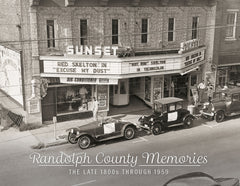Seagrove: Handmade Pottery Capital of the United States
Seagrove, the largest community of pottery makers in the nation, is found in Randolph County, North Carolina. The artisans that reside in this area have dealt with the wanes and surges in popularity for traditional and artistic pottery for over 250 years, and the community is still going strong today.

M. Shofe, a local potter known for his five-gallon churns, circa 1940s.
Courtesy The Courier-Tribune
This timeline illustrates the peaks and valleys of the Seagrove pottery business over the decades.
1700s – An abundance of red clay is uncovered by local potters immigrating to the area, who see the benefit of using it for their functional wares. They may have looked to the Native Americans in the area, whose clay creations were utilized for both daily use and ceremonial practices.
1849 – The construction of 129 miles of plank road through Randolph County and beyond helps potters expand their business to surrounding towns.
1900 – The rise of the glass industry in America nearly wipes out pottery in the area, as people turn away from using clay jugs, bowls, etc.
1917 – Jugtown Pottery, one of the longest standing and most widely known pottery shops from the area, is opened by Juliana and Jacques Busbee.
1920s – Juliana Busbee hires local artisans to provide her with wares to furnish her establishment, revitalizing local business. Jugtown Pottery also expands by opening a store in Greenwich Village, New York City, causing interested tourists from up and down the east coast to venture to Seagrove.

Seagrove-area roadside pottery stand, circa 1940s.
Courtesy The Courier-Tribune
1950s – The building of the interstate diminishes the tourist business for decades.
1976 – The country's centennial celebration starts piquing people's interest in handmade crafts.
1980s - A group of local potters start the N.C. Museum of Traditional Pottery and the Seagrove Pottery Festival, held Thanksgiving weekend every year to this day.
2008 – The Seagrove Area Potters Association is created and members decide to hold their own competing festival. The feud between the two groups brought several years of strain for its members and the town at large, but tension has since dissipated for the most part.
Today – The press surrounding the festival dispute ends up bringing more people to visit the doubled festivities, a silver lining for all involved. Today both festivals continue to be held Thanksgiving weekend.

A Seagrove potter turning clay with foot-power, 1939. Kick wheels are turned with foot power. The kick wheel was revised into a treadle wheel to make the speed of the wheel easier to control and to reduce wear and tear on potters’ hips and legs.
Courtesy The Courier-Tribune
Learn more information about the history of Seagrove here, and see hundreds more beautiful, historic photos of Randolph County in the Courier-Tribune’s new book, Randolph County Memories.

$35.95
$44.95